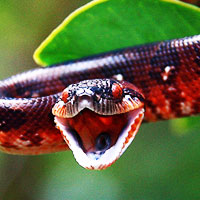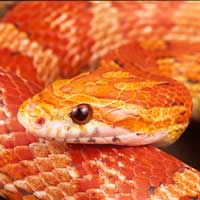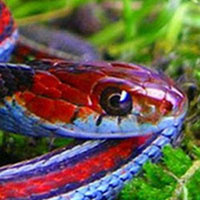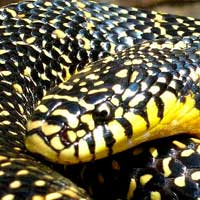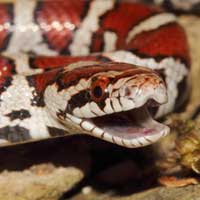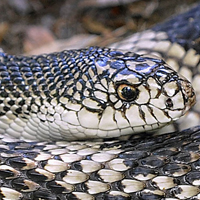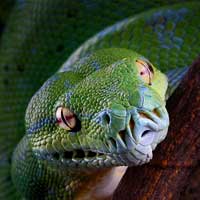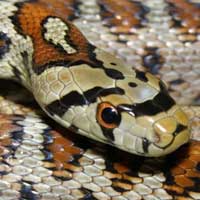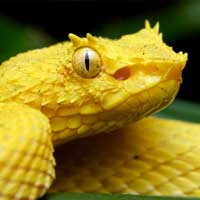Everything You Need to Know About the Brazilian Rainbow Boa
The scientific name of the Brazilian Rainbow Boa is Epicrates cenchria. It belongs to the Boidae family, which includes boas and other constrictor species.
Scientific Name: Epicrates cenchria
Snake Family: Boidae
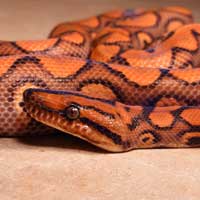
Discover the Beauty and Fascination of the Brazilian Rainbow Boa
The Brazilian Rainbow Boa (*Epicrates cenchria*), known for its iridescent scales and striking color patterns, is one of the most beautiful and sought-after snake species. Native to Brazil and parts of South America, these boas are non-venomous constrictors, making them popular pets among reptile enthusiasts. They are known for their calm temperament, although they can be more active at night. Brazilian Rainbow Boas can grow up to 6 feet long and are often admired for their vivid, rainbow-like sheen, which is a result of the light reflecting off their unique scale structure. Whether you are looking to add one to your collection or simply curious about this exotic snake, this guide will provide comprehensive information on their habitat, diet, behavior, health, reproduction, and care.
Where Do Brazilian Rainbow Boas Live? Understanding Their Natural Habitat
The Brazilian Rainbow Boa is primarily found in the lush, tropical rainforests of Brazil, particularly in the Amazon and surrounding regions. These snakes are arboreal (tree-dwelling) but can also be found in dense vegetation or on the forest floor. They thrive in humid environments, making the Amazon’s high rainfall an ideal home.
Key characteristics of their natural habitat include:
- Climate: Tropical, warm, and humid climate with high levels of rainfall.
- Geographical Location: Mainly found in Brazil’s Amazon Basin, but also in other parts of South America.
- Habitat Preferences: Dense rainforests, riverbanks, and areas with abundant foliage for shelter.
In captivity, replicating these natural conditions is essential for their well-being. High humidity, temperature gradients, and natural hiding spots will help maintain a healthy environment for your Brazilian Rainbow Boa.
What Do Brazilian Rainbow Boas Eat? Their Diet and Feeding Habits
Brazilian Rainbow Boas are non-venomous constrictors that primarily feed on small mammals, birds, and other reptiles in the wild. Their hunting strategy involves ambushing prey, coiling around it, and suffocating it through constriction before swallowing it whole. In captivity, their diet is similar, and they can be fed appropriately sized rodents such as rats and mice.
Feeding Brazilian Rainbow Boas in captivity requires careful attention to size and frequency. Here’s a feeding chart that can guide your feeding schedule:
| Age | Feeding Frequency | Meal Size |
|---|---|---|
| Juvenile | Once a week | Small to medium-sized mice |
| Subadult | Once every 10-14 days | Small rats |
| Adult | Once every 2 weeks | Medium rats or large mice |
It’s important to feed your Brazilian Rainbow Boa at the correct intervals and ensure that the prey is an appropriate size. Overfeeding or underfeeding can lead to health problems, so always adjust feeding schedules as needed based on the snake's age and size.
Brazilian Rainbow Boa Behavior and Temperament: What to Expect
The Brazilian Rainbow Boa is known for its calm and generally docile temperament. While they may be more defensive when first handled, with proper care and patience, they can become accustomed to human interaction. They are naturally nocturnal, so they are most active during the night and tend to rest during the day in a secure hiding spot. Their gentle nature and stunning appearance make them a popular pet, but it’s important to understand their specific behavioral needs.
- Temperament: Typically calm, but can be a bit shy or defensive when young.
- Behavior: Nocturnal and arboreal, preferring to rest in trees or other elevated areas.
- Socialization: They can be socialized with consistent, gentle handling. They might become more tolerant of human contact over time.
- Defensive Behavior: When threatened, they may hiss or strike, but they are not venomous.
By respecting their space and giving them time to adjust, you can create a positive relationship with your Brazilian Rainbow Boa. It's also important to note that they require a quiet and secure environment to feel comfortable, as loud noises or excessive handling can stress them out.
Brazilian Rainbow Boa Health and Lifespan: Keeping Them Healthy
Brazilian Rainbow Boas are generally healthy snakes that can live up to 20 years or more in captivity with proper care. However, they are still susceptible to common reptile health issues, especially if their habitat is not maintained correctly.
Common health concerns include:
- Respiratory Infections: Caused by inadequate humidity or temperature fluctuations.
- Scale Rot: Results from high humidity and poor ventilation, leading to infections of the skin.
- Mites and Ticks: External parasites that can cause irritation and discomfort.
- Obesity: Overfeeding can lead to obesity, affecting the snake's overall health and mobility.
Maintaining an appropriate habitat is crucial to prevent these issues. Ensure a proper humidity range of 60-80% and temperature gradient of 75°F to 85°F, with a basking spot around 90°F. Regular check-ups and attention to their diet and environment can help your Brazilian Rainbow Boa live a long and healthy life.
Brazilian Rainbow Boa Reproduction: How They Breed and Care for Their Young
Brazilian Rainbow Boas breed in the wild during the rainy season, which typically occurs in late summer. They are ovoviviparous, meaning they give birth to live young rather than laying eggs. After mating, the female will carry the developing embryos inside her for several months before giving birth to a litter of up to 15 babies.
Here’s a brief overview of the reproductive process:
- Breeding Season: Typically occurs during the rainy season in the wild (late summer).
- Litter Size: Brazilian Rainbow Boas usually give birth to 6-15 young.
- Gestation Period: The gestation period lasts around 5-7 months before live birth occurs.
After birth, the baby snakes are fully independent and begin hunting small prey immediately. They have the same iridescent coloration as adults, which helps them blend into their surroundings. If you are breeding Brazilian Rainbow Boas in captivity, it’s important to monitor the mother’s health closely, as well as ensure that the babies have an appropriate habitat for growth and development.
Handling and Care Tips for Your Brazilian Rainbow Boa
Brazilian Rainbow Boas require a carefully controlled environment and regular care to thrive. Here are some essential tips for providing the best care for your snake:
- Enclosure: Provide a large enclosure (minimum 4 feet for adults) with secure lid to prevent escape.
- Temperature: Maintain a temperature gradient of 75°F-85°F, with a basking spot of around 90°F.
- Humidity: Keep humidity levels between 60-80%, increasing during shedding periods.
- Substrate: Use substrates like cypress mulch, aspen, or coconut fiber to maintain humidity levels.
- Feeding: Feed appropriately sized prey, such as mice or rats, every 1-2 weeks depending on the snake's size.
- Handling: Handle gently and avoid overstimulating your snake. Begin with short sessions and gradually increase the time as your boa becomes more comfortable.
By providing these conditions and regular care, your Brazilian Rainbow Boa will flourish in captivity. Regular cleaning, proper feeding, and consistent temperature and humidity levels are key to keeping them healthy and happy for many years.
